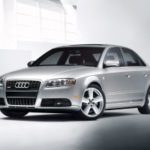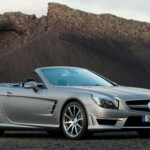Intercooler, compressed air cooler
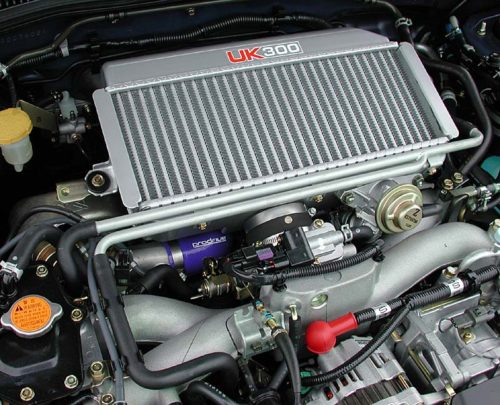
Intercooler
The intake air cooling increases the power by 10 to 20 percent
You have probably noticed the difference in engine performance, that is, the throttle response, between driving on a fresh night and a hot summer day. At night, the engine runs better, has more power and a better throttle response. Why? Due to the lower air temperature that the engine is sucking. But why is the lower temperature conducive to engine operation? The cooler air is denser and more mass can be sucked in in the same cycle and more fuel can be burned.
This increases power. All efforts to increase engine power are reduced to one, to increase the amount of burned fuel in the cylinders. At first glance, this does not sound particularly difficult, but with the increase in the amount of fuel, the need for air increases. It takes close to 15 grams of air to burn one gram of fuel, so increasing the amount of fuel proportionally increases the need for air, which is not easy to secure.
Various 'tricks' are used, increasing the number of intake valves, reducing the flow resistance…, and the most important is pre-charging, ie compressed air that is sent to the cylinders. Precharging increases the air pressure, which means a larger mass in the same volume. It is the mass of air that is important in the combustion process. The problem is that by increasing the pressure, the air temperature also increases, which thus expands and reduces the density, which is the opposite of what we want to achieve.
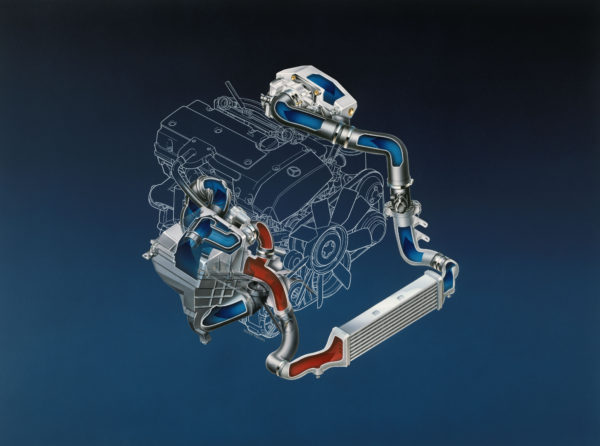
Intercooler
The air in the compressor (turbo or mechanical) is heated to 2 ° C by compression at 150 bar. Therefore, in order to increase the mass of air that is injected into the cylinders, it is necessary to reduce the temperature. The intercooler is located between the compressor and the engine and the compressed intake air on the way to the engine passes through it and cools down. It is basically a heat exchanger, for example, found in a home refrigerator.
There are two basic versions, ‘air-to-air’ and ‘air-to-water’. The air-to-air version is simpler and more frequent, the compressed air flows through an exchanger (honeycomb pipe system) around which the surrounding air flows cools it. In some (mostly sports) versions, water is sprayed on the heat exchanger, which increases the cooling intensity. The ‘air-to-water’ version uses closed-air water to cool the compressed air, which is also air-cooled.
It is more complex and expensive. The compressed intake air is cooled to about 50 ° C. With high-load motors with two intercoolers, the temperature drop can be as high as 100 ° C. Although cooling the compressed air reduces the pressure by about 0,1 bar, the effect on the power increase is very positive. Intercoolers are more used in turbodiesel engines, due to higher air requirements and, of course, in racing turbo gasolines.
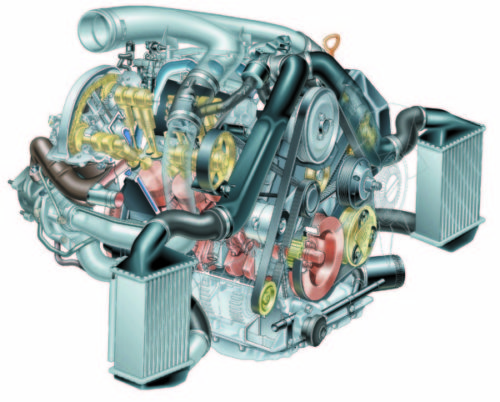
Intercooler
Duel solution: Intercooler or aftercooler? Although a compressed air cooling device is commonly referred to as an ‘intercooler’ this is not always true. An intercooler is a device that cools the air between two stages of precharging. while most of today’s devices cool the air after compression, to be more precise ‘aftercooler’. Therefore, a compressed air cooler is the most appropriate name, no matter where it is located.
Here's a formula from the 80's: Volkswagen Golf 1.6 D, 'two' from the 80's had 54 hp, 1.6 TD with a turbocharger, had 70 hp, and with an intercooler 80 hp (it was also installed in the Passat. And now data for racing engines with a turbocharger. The engine is at 10.000 / min and with a preload pressure of 4 bar developed about 900 hp.
By flowing through the compressor, ie the charger, the suction air is heated and heat is transferred from the hot turbine, whose temperature reaches 1000 ° C. The air temperature at the outlet of the compressor is 253 ° C, and the air mass is about 450 kg / h. With the use of an intercooler, the suction temperature is reduced to 145 degrees.
The flow resistances in the intercooler and the drop in temperature result in a slightly lower pressure at the outlet of the cooler, but nevertheless the total mass of the intake air increases to 480 kg / h. The specific power of the turbodiesel is charged by the intercooler to as much as 127 hp / l. Water-air coolers are more compact and expensive, due to the need for additional parts: pump, lines, connections, valves…
By lowering the temperature of the compressed air, it increases the density and can be pushed more into the cylinders, thereby achieving a tuning effect. Intercooler efficiency is the ratio of the amount of temperature reduction inside the intercooler and the air temperature before the intercooler. Amounts from 60 to 75% for air-to-air version 70 to 90% for air-to-water.
The first installation of a compressed air cooler dates from 1910 and was not used in an engine but in an air compressor. The first major use of the intercooler was in the engines of fighter jets in World War II, and in 2 it was incorporated into the first marine engine. With the installation of the first turbocharger in the car in 1956 (Oldsmobile Jetfire), more widespread use in cars began.
Its good to know:
It is mounted from behind the front bezel
Above code only boxer motor, for others impossible due to pedestrian protection regulations
LIQUID CO2
In drag-race races in compressed air coolers, liquid CO 2 is used, which is at -60 ° C, for more intensive cooling.
WATER FOR GLASSES
Some windscreen washer water is sprayed into the intercooler to increase cooling efficiency: very cheap and relatively efficient.
BACK THE WEIGHTS
In the case of a car with a motor in the back, water-air coolers are more common because of the problematic placement of the exchanger in the air stream
DOESN'T HELP ALWAYS
Poor performance can lead to insufficient cooling and a significant drop in compressed air pressure, which ultimately reduces power
WATER FASTERS COOL
The water-to-air performance generally lowers the air temperature faster and helps remove the turbo hole
Author: Matko Jovic
Retrieved from: www.autoportal.hr
Recommendation of similar texts:

Hi there, I am Mladen and I am an auto enthusiast. I started this blog years ago to help like minded people share information about latest cars, car servicing ideas, used car info, exotic cars, and auto technology. You will find helpful articles and videos on a wide variety of cars - Audi, Mercedes, Toyota, Porsche, Volvo, BMW and much more. Ping us if you have anything cool to share on latest cars or on how to make older cars more efficient, or just want to say hi!


